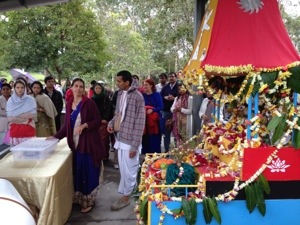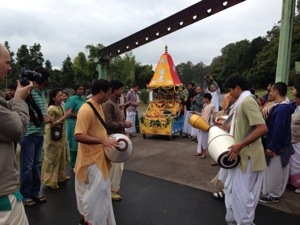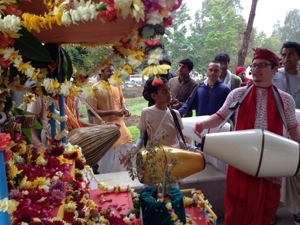Houston Festival of Chariots Video clips by Gaby
Brisbane Rathayatra
→ Ramai Swami

This year the Brisbane temple community observed the Jagannatha Rathayatra in the nearby park at the bottom of the hill. This park has been developed by the city council to facilitate nice water, lawn and playground areas for families.
The deities of Jagannatha, Baladeva and Subhadra rode majestically in a special purpose built cart for Their pleasure. It was not a big cart, but Their Lordships looked happy being pulled by hundreds of chanting and dancing devotees on various pathways around the park.
This year the weather was a little drizzly but that didn’t dampen the mood of the ecstatic devotees. At the end a sumptuous feast was served back at the temple. Lord Jagannatha Ki Jaya!
Newly added Youtube videos
→ ISKCON Scarborough
ISKCON Montreal 2013 Rath Yatra - video:
ISKCON Toronto- class and presentation by HG Dravida dasa
Home program at Scarborough - HG Dravida das
HG Madhava das Kirtan:
Bhagavad Gita 15th chapter overview by Nityananda Chandra das
→ Nityananda Chandra Das' Blog, ISKCON Dallas
Newly added Youtube videos
→ ISKCON Scarborough
ISKCON Montreal 2013 Rath Yatra - video:
ISKCON Toronto- class and presentation by HG Dravida dasa
Home program at Scarborough - HG Dravida das
HG Madhava das Kirtan:
Bhagavad Gita 15th chapter overview by Nityananda Chandra das
→ Nityananda Chandra Das' Blog, ISKCON Dallas
Monday, July 15th, 2013
→ The Walking Monk
Toronto, Ontario
Our cook Apurva just loves moving his feet after the morning arati. He’ll do it alone as he often times has to, but when I’m around it will be a routine question from him, “Are we going?” I don’t decline very often unless I’ve already tackled the sidewalk and put in some kilometres before the arati. So this morning we left for a jaunt in the Annex area.
Apurva came to me with a different question now, “Can you cook?” Meaning the noon cooking, a rather substantial amount which includes doing some preps for Govinda’s, our vegetarian dining facility open to the public. He knows I have a passion for culinary activities, and with all the aftermath of a 2 day intensive festival just behind us, he had become a bit short staffed.
Cruel as I was, I actually passed on this one, even though he came to me as a desperado. I committed the sin and felt the weight of guilt with initial apprehension. I should have sprung up in enthusiastic anticipation. It was short notice, I was caught off guard, and it met with a stunning mode. I really don’t like to let someone down, especially him, but I had to be honest about my availability. Fortunately we both got off the hook so to speak, when in the moment of ‘what to do’ a person volunteered. Apurva had a sigh of relief.
I like cooking almost as much as I like eating, in fact, I was flattered when at my last kitchen endeavour I put together a veg and spice concoction
and Apurva began tailgating me for the recipe. I say that with affection. The prep was tasty by the way, a squash and cauliflower combination.
In conclusion to this simple narrative I simply want to say that I really appreciate all that my god brother Apurva does, everything from his walking to cooking to being a stalwart at morning arati, meditation, studying , to orchestrating kitchen work and finally to being a good friend and always wanting to keep in the company of those who reflect an inkling of what is spiritual.
Thanks, Apurva, for being who you are.
12 KM
Monday, July 15th, 2013
→ The Walking Monk
Toronto, Ontario
Our cook Apurva just loves moving his feet after the morning arati. He’ll do it alone as he often times has to, but when I’m around it will be a routine question from him, “Are we going?” I don’t decline very often unless I’ve already tackled the sidewalk and put in some kilometres before the arati. So this morning we left for a jaunt in the Annex area.
Apurva came to me with a different question now, “Can you cook?” Meaning the noon cooking, a rather substantial amount which includes doing some preps for Govinda’s, our vegetarian dining facility open to the public. He knows I have a passion for culinary activities, and with all the aftermath of a 2 day intensive festival just behind us, he had become a bit short staffed.
Cruel as I was, I actually passed on this one, even though he came to me as a desperado. I committed the sin and felt the weight of guilt with initial apprehension. I should have sprung up in enthusiastic anticipation. It was short notice, I was caught off guard, and it met with a stunning mode. I really don’t like to let someone down, especially him, but I had to be honest about my availability. Fortunately we both got off the hook so to speak, when in the moment of ‘what to do’ a person volunteered. Apurva had a sigh of relief.
I like cooking almost as much as I like eating, in fact, I was flattered when at my last kitchen endeavour I put together a veg and spice concoction
and Apurva began tailgating me for the recipe. I say that with affection. The prep was tasty by the way, a squash and cauliflower combination.
In conclusion to this simple narrative I simply want to say that I really appreciate all that my god brother Apurva does, everything from his walking to cooking to being a stalwart at morning arati, meditation, studying , to orchestrating kitchen work and finally to being a good friend and always wanting to keep in the company of those who reflect an inkling of what is spiritual.
Thanks, Apurva, for being who you are.
12 KM
TEXAS FAITH 106: Do the political comebacks of scandal-marred politicians mean we’re forgiving or indifferent?
→ Nityananda Chandra Das' Blog, ISKCON Dallas
 Dallas Morning News,
Dallas Morning News,
Each week we will post a question to a panel of about two dozen clergy, laity and theologians, all of whom are based in Texas or are from Texas. They will chime in with their responses to the question of the week. And you, readers, will be able to respond to their answers through the comment box.
Whatever happened to shame? It wasn’t that long ago that a politician tainted by a sex scandal or caught cheating on a spouse was finished in public life. But a couple of political comebacks this year illustrate how things have changed. Two years after he resigned from Congress for sending a sexually suggestive picture of himself to a follower on Twitter, Anthony Weiner is in contention for mayor of New York City. Eliot Spitzer abandoned the state’s governor’s race in 2008 in disgrace following reports he frequented high-end prostitutes. He could be the city’s next controller.
And they’re not alone. Mark Sanford was elected to Congress in South Carolina after admitting an affair in 2009. David Vitter overcame scandal when his name showed up on the customer list of the “D.C. Madam” in 1999, winning reelection to the Senate and is at the top of the GOP list to be the next governor of Louisiana. And Bill Clinton, despite the White House intern scandal, is more popular than ever.
What’s happened? What does it say about the culture that behavior once considered inappropriate or indecent, doesn’t pack the same punch it once did. Are we more understanding, more willing to forgive? Or have we just become indifferent? In politics and religion, no narrative is more powerful than the backslider redeemed. But there’s another tradition in politics: we hold the leaders we elect to office to certain standards and believe that failure to meet those standards has consequences.
Here’s this week’s question: What do recent political comebacks by scandal-tarred politicians say about our culture? Have we become more tolerant and forgiving or grown more callous and indifferent
NITYANANDA CHANDRA DAS, minister of ISKCON (International Society for Krishna Consciousness), Dallas
In the past, duty was of importance. Duty means acting in such a way that is helpful to everyone. By the influence of time, people have become more and more selfish and therefore concepts such as duty cannot even be conceived of by the common man. Selfish life has now become the norm.
The ancient Mahābhārata describes that in the days of yore, political leaders would gladly give up their life rather than go against their vows. For this reason and others the citizens experienced a parental relationship between the leaders and themselves. A genuine feeling of care.
The more we connect with Krishna, God (God has many names), the more we feel satisfied. Thus the propensity of selfishness gradually recedes. This connection can easily by established by calling on God’s holy names such as Hare Krishna.
A leader with selfless standards inspires their citizens with the greatness of selfless love.
To see all responses of the TEXAS Faith panel click here.
TEXAS FAITH 106: Do the political comebacks of scandal-marred politicians mean we’re forgiving or indifferent?
→ Nityananda Chandra Das' Blog, ISKCON Dallas
 Dallas Morning News,
Dallas Morning News,
Each week we will post a question to a panel of about two dozen clergy, laity and theologians, all of whom are based in Texas or are from Texas. They will chime in with their responses to the question of the week. And you, readers, will be able to respond to their answers through the comment box.
Whatever happened to shame? It wasn’t that long ago that a politician tainted by a sex scandal or caught cheating on a spouse was finished in public life. But a couple of political comebacks this year illustrate how things have changed. Two years after he resigned from Congress for sending a sexually suggestive picture of himself to a follower on Twitter, Anthony Weiner is in contention for mayor of New York City. Eliot Spitzer abandoned the state’s governor’s race in 2008 in disgrace following reports he frequented high-end prostitutes. He could be the city’s next controller.
And they’re not alone. Mark Sanford was elected to Congress in South Carolina after admitting an affair in 2009. David Vitter overcame scandal when his name showed up on the customer list of the “D.C. Madam” in 1999, winning reelection to the Senate and is at the top of the GOP list to be the next governor of Louisiana. And Bill Clinton, despite the White House intern scandal, is more popular than ever.
What’s happened? What does it say about the culture that behavior once considered inappropriate or indecent, doesn’t pack the same punch it once did. Are we more understanding, more willing to forgive? Or have we just become indifferent? In politics and religion, no narrative is more powerful than the backslider redeemed. But there’s another tradition in politics: we hold the leaders we elect to office to certain standards and believe that failure to meet those standards has consequences.
Here’s this week’s question: What do recent political comebacks by scandal-tarred politicians say about our culture? Have we become more tolerant and forgiving or grown more callous and indifferent
NITYANANDA CHANDRA DAS, minister of ISKCON (International Society for Krishna Consciousness), Dallas
In the past, duty was of importance. Duty means acting in such a way that is helpful to everyone. By the influence of time, people have become more and more selfish and therefore concepts such as duty cannot even be conceived of by the common man. Selfish life has now become the norm.
The ancient Mahābhārata describes that in the days of yore, political leaders would gladly give up their life rather than go against their vows. For this reason and others the citizens experienced a parental relationship between the leaders and themselves. A genuine feeling of care.
The more we connect with Krishna, God (God has many names), the more we feel satisfied. Thus the propensity of selfishness gradually recedes. This connection can easily by established by calling on God’s holy names such as Hare Krishna.
A leader with selfless standards inspires their citizens with the greatness of selfless love.
To see all responses of the TEXAS Faith panel click here.
Why work harder than the animals for what the animals get?
→ The Spiritual Scientist
People are being educated and trained to work very hard for sense gratification. and there is no sublime aim in life. A man travels to earn his livelihood. leaving home early in the morning, catching a local train and being packed in a compartment. He has to stand for an hour or two in order to reach his place of business. Then again he takes a bus to get to the office. At the office he works hard from nine to five; then he takes two or three hours to return home. After eating, he has sex and goes to sleep. For all this hardship, his only happiness is a little sex. Yan maithunadi-grhamedhi-sukham hi tuccham. Rsabhadeva clearly states that human life is not meant for this kind of existence, which is enjoyed even by dogs and hogs. Indeed, dogs and hogs do not have to work so hard for sex. A human being should try to live in a different way and should not try to imitate dogs and hogs. The alternative is mentioned. Human life is meant for tapasya, austerity and penance. By tapasya, one can get out of the material clutches. When one is situated in Krsna consciousness, devotional service, his happiness is guaranteed eternally.
19 July 2013 – Sayana Ekadashi
→ ISKCON Desire Tree
19 July 2013 – Sayana Ekadashi
→ ISKCON Desire Tree
Come Dance With Us!
→ travelingmonk.com
Towards the final few days of this years Scandinavian Ratha Yatra tour, the team…
→ Mahavishnu Swami
Prabhupada Letters :: Anthology 2013-07-16 16:33:00 →
Prabhupada Letters :: 1966
Prabhupada Letters :: Anthology 2013-07-16 16:31:00 →
Prabhupada Letters :: 1966
Prabhupada Letters :: Anthology 2013-07-16 16:26:00 →
Prabhupada Letters :: 1968
Prabhupada Letters :: Anthology 2013-07-16 16:24:00 →
Prabhupada Letters :: 1969
Prabhupada Letters :: Anthology 2013-07-16 16:22:00 →
Prabhupada Letters :: 1970
Prabhupada Letters :: Anthology 2013-07-16 16:21:00 →
Prabhupada Letters :: 1970
Prabhupada Letters :: Anthology 2013-07-16 16:14:00 →
Prabhupada Letters :: 1975
Prabhupada Letters :: Anthology 2013-07-16 16:11:00 →
Prabhupada Letters :: 1975
Is the state of faith at the level of chidanti sarva samshya same as that at Nistha stage?
→ The Spiritual Scientist
From Advaita Murti Pr
Part of Monday evening’s bhajan – an old tune
→ SivaramaSwami.com
Is there benefit even if we chant without hearing?
→ The Spiritual Scientist
From Latha M:
How can there be stool and urine in the spiritual world?
→ The Spiritual Scientist
From Mukunda Pr:
Very Dear to Krishna
→ HH Bhakti Caitanya Swami
Mahavishnu Swami spent the last two weeks on the Scandinavian Tour. He was suppo…
→ Mahavishnu Swami
New Vrindaban’s Ratha Yatra Sat. July 20, 2013
→ New Vrindaban Brijabasi Spirit
Lord Jagannatha, Lord Balarama and Lady Subhadra are recovering from their Snana Yatra (bathing ceremony) and will make a big comeback this coming Sat. July 20, 2013 at 11 AM at New Vrindaban’s RATHA YATRA.
Everyone is invited.
If you’d like, please bring an offering for the Lord.
JAYA JAGANNATHA!!!!
From brahmacarya to sannyasa Vaisnavas cultivate devotion laced with knowledge and detachment
→ SivaramaSwami.com
July 16th, 2013 – Darshan
→ Mayapur.com
The post July 16th, 2013 – Darshan appeared first on Mayapur.com.
Vishvambar Leads During New Vrindaban’s 24 Hour Kirtan – June 15th, 2013
→ New Vrindaban Brijabasi Spirit
Video of Vishvambar leading during New Vrindaban’s 24 Hour Kirtan - June 15th, 2013. Thanks to Bhakta Vatsala Dasa for posting them on Youtube.
24 Hour Kirtan at New Vrindavan – 2013 – Kirtan by HG Madhava das
→ Gouranga TV - The Hare Krishna video collection
24 Hour Kirtan at New Vrindavan – 2013 – Kirtan by HG Madhava das
Relationship With Chanting
→ Japa Group
Everyone has a different relationship with chanting and when they connect with the process strongly, they usually feel protected or comfortable. I talked to someone today and she said she takes shelter of the Holy names when she has strong fear and feel all the protection coming from chanting. Another person chants because the names of the Lord reminds this person of the amazing pastimes of the Lord, maybe others chant to connect with the spiritual master and to be always reminded how amazing Harinama initiation is on the path of devotional service.
Whatever is our relationship with chanting, we will always be grateful to have got this chanting.
Hoping your week is full of realizations.
your servant,
Aruna devi
Relationship With Chanting
→ Japa Group
Everyone has a different relationship with chanting and when they connect with the process strongly, they usually feel protected or comfortable. I talked to someone today and she said she takes shelter of the Holy names when she has strong fear and feel all the protection coming from chanting. Another person chants because the names of the Lord reminds this person of the amazing pastimes of the Lord, maybe others chant to connect with the spiritual master and to be always reminded how amazing Harinama initiation is on the path of devotional service.
Whatever is our relationship with chanting, we will always be grateful to have got this chanting.
Hoping your week is full of realizations.
your servant,
Aruna devi
SB 7.9.50 The resolution to engage in devotional service with the implicit prayer for aid in keeping that resolution is the conclusive prayer
→ The Spiritual Scientist
02.68 – Beware of the heart attack that makes us morally unconscious
→ The Spiritual Scientist
Heart attacks are among the most feared things today. They may reduce a healthy, normal person to an unconscious heap on the ground in a matter of minutes.
There’s another kind of heart attack that’s just as dreadful, though it is not widely recognized as such. This heart attack afflicts not the physical heart, but the metaphorical heart – the seat of emotions. One major source of such heart attacks is lust.
The Srimad Bhagavatam (6.1) describes how the cultured Ajamila became a victim of such a heart attack. The attack began with his eyes when he saw a society woman in action. Lust soon took over his heart and made him into its slave. To satisfy lust, he abandoned his faithful wife, his dependent parents and his respectable vocation as a priest – all the while remaining deaf to the shocked remonstrations of his loved ones.
A physical heart attack makes us physically unconscious, whereas the lust-induced heart attack makes us spiritually and morally unconscious. A physical heart attack makes us physically inactive; whereas the lust-induced heart attack often makes us hyper-active. It impels us to seek frantically the object that will gratify the lust, in the process casting aside morality as if it were a useless rag.
Our culture with its blatant sexual imagery makes us especially vulnerable to such visually triggered heart attacks. That’s why the Bhagavad-gita’s (02.68) injunction to constantly guard our senses is not a puritanical prohibition; it is a practical and essential precaution.
Gita wisdom guides us to not just prevention but also immunization. We can satisfy our eyes’ thirst for beauty and our heart’s thirst for love with all-beautiful, all-loving Krishna. When we enthrone him as the Lord of our heart, the attacks of lust can no longer penetrate there.
***
Therefore, O mighty-armed, one whose senses are restrained from their objects is certainly of steady intelligence.
Upcoming Seminar: Vaishnava Etiquette
→ ISKCON Melbourne, AU

Srila Prabhupada writes: It is the characteristic of a devotee to observe and protect Vaishnava etiquette...this is the ornament of a devotee." (ISKCON Founder-Acharya His Divine Grace A.C. Bhaktivedanta Swami Prabhupada, Cc. Antya 4.130).
Bhakti Charu Maharaja cites Srila Sanatana Goswamis Hari-bhakti-vilasa: Since nothing can be successful without sadachara or etiquette, every action should be performed with proper etiquette. We must act according to proper etiquette. The heart of a saintly person is free from contamination. The way a saintly person acts is known as proper etiquette. A way a saintly person acts is know as sadachara..."If a person reads the six branches of the Vedas without practicing proper etiquette, he does not get purified, just as a bird flies away from the nest as soon as it grows wings, the Vedas leave him at the time of his death...Thus one can understand that Vaishnava etiquette purifies the heart and the consciousness.
The time and venue for this seminar are: June the 22nd, 7:30pm in the Temple Theatre. Everyone is welcome, so please join us.
If I am facing problems with my counselor’s behavior towards me, should i tell him directly or to some other senior devotee?
→ The Spiritual Scientist
From Aravind




